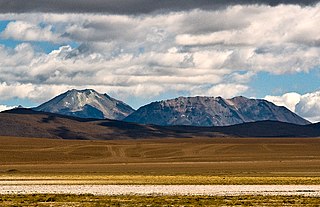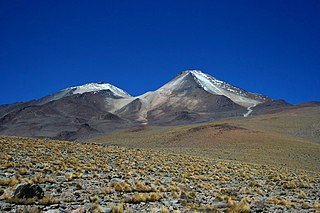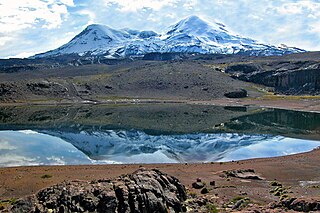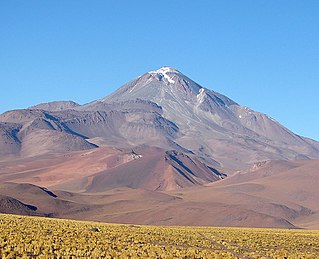| Inka Qhamachu | |
|---|---|
| Highest point | |
| Elevation | 4,792 m (15,722 ft) [1] |
| Coordinates | 18°51′13″S68°12′42″W / 18.85361°S 68.21167°W Coordinates: 18°51′13″S68°12′42″W / 18.85361°S 68.21167°W |
| Geography | |
| Location | Bolivia Oruro Department |
| Parent range | Andes |
Inka Qhamachu (Quechua Inka Inca, qhamachu a species of wild tobacco (Nicotiana glauca), [2] Hispanicized names Inca Camacho, Incacamachi) is a 4,792-metre-high (15,722 ft) mountain in the Andes of Bolivia. It is located in the Oruro Department, Litoral Province, Huachacalla Municipality. Inka Qhamachu lies southeast of Pacha Qullu, southeast of the village of Huachacalla (Wachaqalla). [3]

The Inca Empire, also known as the Incan Empire and the Inka Empire, was the largest empire in pre-Columbian America. Its political and administrative structure is considered by most scholars to have been the most developed in the Americas before Columbus' arrival. The administrative, political and military center of the empire was located in the city of Cusco. The Inca civilization arose from the Peruvian highlands sometime in the early 13th century. Its last stronghold was conquered by the Spanish in 1572.

Nicotiana glauca is a species of wild tobacco known by the common name tree tobacco. Its leaves are attached to the stalk by petioles, and its leaves and stems are neither pubescent nor sticky like Nicotiana tabacum. It resembles Cestrum parqui but differs in the form of leaves and fusion of the outer floral parts. It grows to heights of more than two meters.

The Andes or Andean Mountains are the longest continental mountain range in the world, forming a continuous highland along the western edge of South America. This range is about 7,000 km (4,300 mi) long, about 200 to 700 km wide, and of an average height of about 4,000 m (13,000 ft). The Andes extend from north to south through seven South American countries: Venezuela, Colombia, Ecuador, Peru, Bolivia, Chile and Argentina.
Inka Qhamachu is part of the Altiplano, an area of the Andes lying at altitudes of 3,600–4,000 metres (11,800–13,100 ft). The Altiplano has been affected by volcanic activity. Most of it including Inka Qhamachu is extinct, but in the Western Cordillera volcanic activity persists at Cerro Quemado, Guallatiri, Parinacota, Sajama and Tata Sabaya. [4]

The Altiplano, Collao, Andean Plateau or Bolivian Plateau, in west-central South America, is the area where the Andes are the widest. It is the most extensive area of high plateau on Earth outside Tibet. The bulk of the Altiplano lies in Bolivia, but its northern parts lie in Peru, and its southern parts lie in Chile and Argentina.
Cerro Quemado is a mountain in the Andes Mountains of Argentina. It has a height of 6,184 metres (20,289 ft).

Guallatiri is a 6,071-metre-high (19,918 ft) volcano in Chile. It is located southwest of the Nevados de Quimsachata volcanic group and is sometimes considered to be part of that group. It is a stratovolcano with fumaroles around the summit, which may be either a lava dome or a pyroclastic cone. The lower flanks of the volcano are covered by lava flows and lava domes; the volcano has erupted mainly dacite along with andesite and rhyolite.
Inka Qhamachu is a Pliocene age volcano, [4] which rises from an altitude of 3,700 metres (12,100 ft). [5] Its slopes range 11–16°, formed by lava flows and pyroclastic material. Erosion has carved radial gullies into its flanks, at whose ends alluvial fans have formed. [4] Based on the degree of erosion, an age of 7.5 million years has been estimated. The volume of the edifice once was about 50.9 cubic kilometres (12.2 cu mi). [5]
The Pliocene Epoch is the epoch in the geologic timescale that extends from 5.333 million to 2.58 million years BP. It is the second and youngest epoch of the Neogene Period in the Cenozoic Era. The Pliocene follows the Miocene Epoch and is followed by the Pleistocene Epoch. Prior to the 2009 revision of the geologic time scale, which placed the four most recent major glaciations entirely within the Pleistocene, the Pliocene also included the Gelasian stage, which lasted from 2.588 to 1.806 million years ago, and is now included in the Pleistocene.
Temperatures in the closely located city of Oruro range 4–12 °C (39–54 °F), and precipitation is 400–100 millimetres (15.7–3.9 in). The area is very windy. This climate has led to a xerophytic vegetation, including shrubs and tussock grass. [4]

Oruro or Uru Uru is a city in Bolivia with a population of 264,683, about halfway between La Paz and Sucre in the Altiplano, approximately 3,709 meters (12,169 ft) above sea level.

A shrub or bush is a small- to medium-sized woody plant. Unlike herbaceous plants, shrubs have persistent woody stems above the ground. They are distinguished from trees by their multiple stems and shorter height, and are usually under 6 m (20 ft) tall. Plants of many species may grow either into shrubs or trees, depending on their growing conditions. Small, low shrubs, generally less than 2 m (6.6 ft) tall, such as lavender, periwinkle and most small garden varieties of rose, are often termed "subshrubs".















